HYM Investments vpurchased Suffolk Downs, 160 acres of essentially open space, for $155 million. It’s the largest undeveloped parcel in the City and is served by two stops on the MBTA’s Blue Line: Suffolk Downs and Beachmont. On May 26 The Globe reported that HYM closed on the deal and revealed the developer’s plans. In a word, they stink.
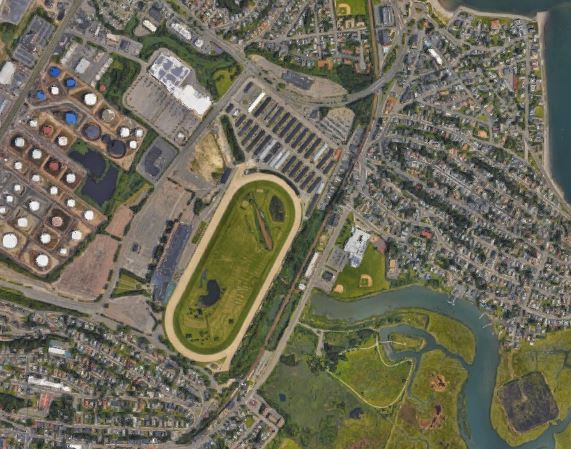
Jon Chesto and Tim Logan reported that HYM managing director Tom O’Brien wants to put apartments, shops and offices on pedestrian-friendly blocks. Then they said this: “He has few specifics just yet, but points to the succesful Assembly Row complex in Somerville as an example of the kind of project he has in mind for Suffolk Downs.”
Ugh. This shouldn’t be hard and it isn’t.
Assembly Row, or Assembly Square, or whatever it’s called these days is a hideous example of cargo cult urbanism. Supposedly designed on New Urbanist principles (and earning Somerville mayor Joe Curtatone an award from the Congress for the New Urbanism New England chapter), the only nearly succesful thing about it is the architecture, which is just okay.
The streets are all at least 100 feet from building to building and have queing lanes and sweeping curbs. The huge streets don’t even have bike lanes! And parking. There’s a lot of free onstreet parking, as well as an awful lot of free garage parking. In fact, the dominant structure type is parking garage. There appears to be about eight parking garages for every store and apartment.
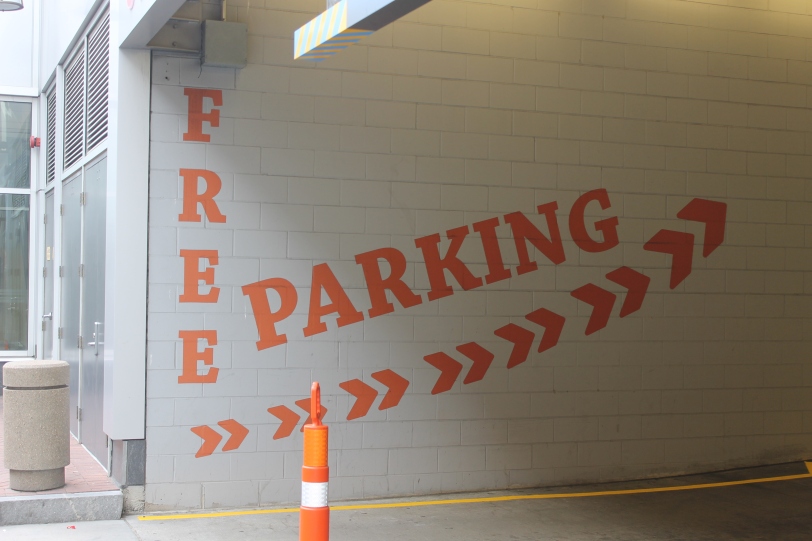
Now, the interesting think about Assembly Row is that part of building it involved an infill station on the Orange Line, Assembly. The idea being that people would take the T to get there and go other places. But with all of that free parking why would anyone want to take the T? Well, they don’t: Assembly, which opened three years ago, has the least passengers on the entire Orange Line. Only a few Blue Line stations and Green Line stations have a lower ridership system-wide.
And it surely doesn’t help that if you do take the T to Assembly, you are greeted with a) a bunch of parking garages b) a construction site and c) a bunch of roads with closed sidewalks and detritus and other nastiness that makes you wonder if that the station is really open.
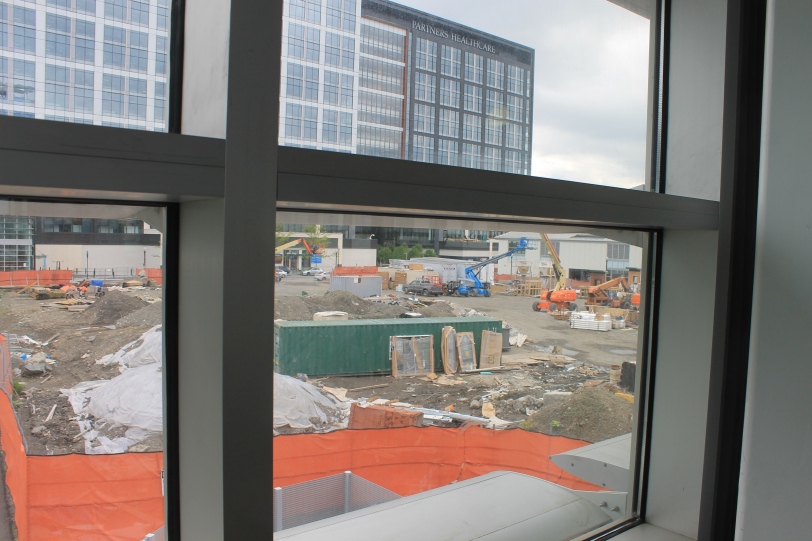
What an inviting view! Looks great for walking.
Here’s an idea: if you don’t build parking, especially oodles of free parking, people would be more inclined to get there by transit. Newbury Street: not a lot of parking, plenty of people walking, biking and taking transit. Downtown Boston: parking is scarce and expensive, lots of crowded trains. North End: not only is there not a lot of parking, but the streets are narrow. Everybody walks
The North End is how Suffolk Downs should be redeveloped. No parking, high lot coverage, narrow streets. Actually urban instead of the “Ye olde towne centre” fakery of Assembly Square. They could even platt it out into small lots of 20 feet by 40 feet and sell them to small developers. A North End-style development could provide 40,000 homes and not add more than a handful of cars. The 143 acres of Assembly Square, on the other hand, will be home to just 3500 people, according to Curbed. And about 120,000 automobiles by the looks of things.
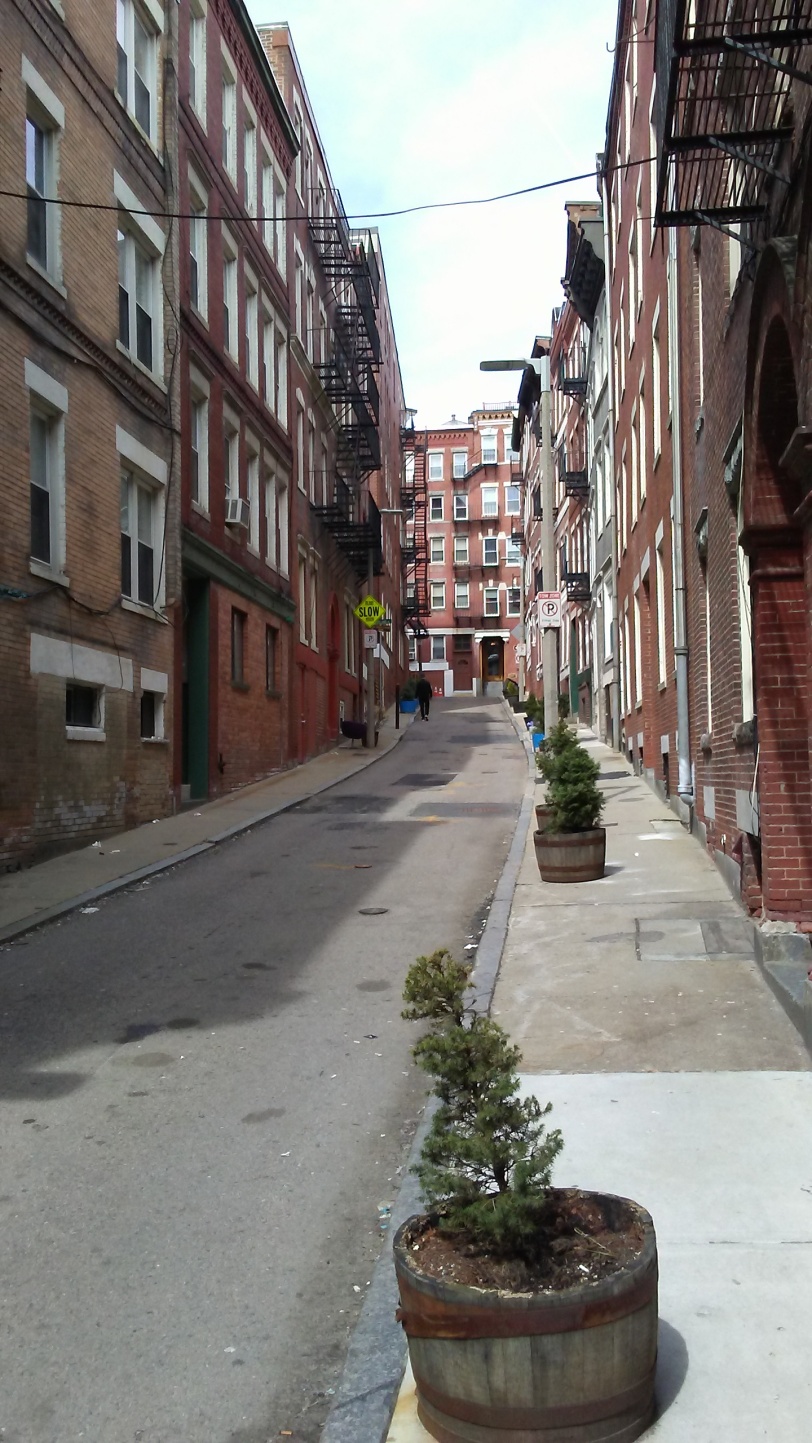
This is the North End.
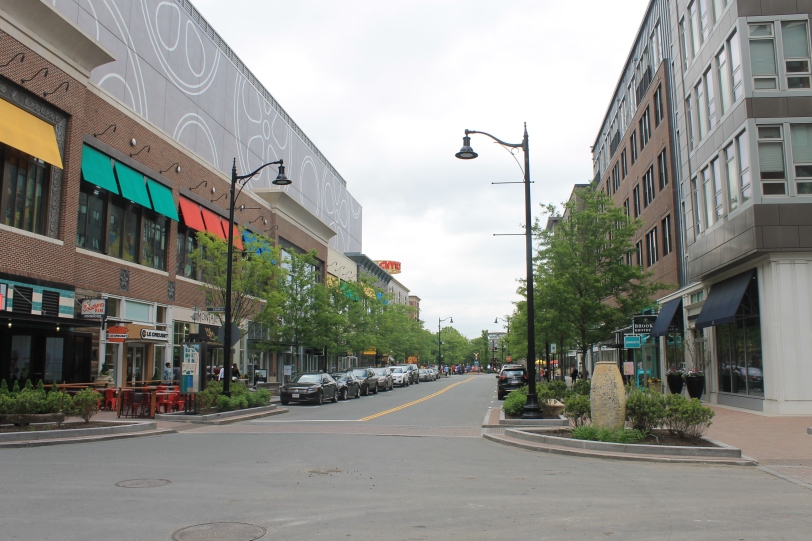
This is Assembly Square.
This isn’t difficult at all. Building more housing is always good, but building more dangerous streets, more vast parking garages, more places that just recapitualate the worst failures of 20th century urban planning is a slap in the face to everyone who wants the city to succeed and be a place for people, not a car storage facility with a juice bar on the corner.
“The 143 acres of Assembly Square, on the other hand, will be home to just 3500 people”
This should read “Suffolk Downs”, right?
Nope. Assembly Square is 143 acres, most of it roadway and surface parking. At full build out it will only have 3500 residents.
It’s worth pointing out that the North End has plenty of trees and parks too. The last two photos contrasting North End’s density with Assembly Square’s new urbanism may give the impression that density is incompatible with street trees.
Modeling the new development on other North End streets, such as Greenough Lane could also accommodate tens of thousands of homes.
Photos of Greenough Lane: http://bostonzest.typepad.com/.a/6a00e54fc42bb888340168ebf24364970c-500wi

Suffolk Downs also has a different transportation context from Assembly Square. Assembly is just off I-93, a major traffic artery providing relatively easy access to everything north of Boston, and slightly less easy but still not impossible access to the south as well. Suffolk Downs, on the other hand, has Route 1A, which provides rather slower and more congested access to the north via surface roads and to the south and west via congested tunnels. It’s less likely to become a regional retail destination for the simple reason that it’s hard to get to, and would do better to take advantage of the access to Downtown jobs provided by the Blue Line and build a ton of housing together with more local-scale retail.
Tell me that they are not overbuilding residential property in the Greater Boston Area? Also, Retail malls are dying and we hear everyday how the retailers are struggling to make a profit? Shades of the mid 1980’s when eventually in the early 90’s properties were foreclosed upon and sold at auction for fractions of the 80’s asking price! Could we be heading I that direction again?
I agree with the general point that we should be looking towards more urban environments but your comparison between the North End and Assembly Row is not fair. To start with, Assembly is not yet at full build, which will fill in the plots closer to the T station. The feel of the area is evolving and that’s not even to count future plans for the Strip Mall across the street. The streets of Assembly Row are anything but high speed thorough fares, cars rarely exceed 25 mph and the area is very pedestrian friendly.
For the visual comparison between Assembly and the North End – You’ve selected a picture of a small side street – (Margaret I believe) that doesn’t any commercial space on it. A better comparison would be to Hanover, which is pretty damn similar in width and parking to Assembly except it has smaller sidewalks (Unlikely to be ADA Accessible). Further, the North End is also supplemented by a number of nearby parking garages (Government Center, Parcel 7, Commercial Street/Hull Street to name a few). To say the North End is car free is a gross exaggeration. Try driving down Hanover at 7pm on a Saturday and you could crawl faster. For the garages in Assembly, the sad reality is that for the time being, people still need to commute to their jobs on the 128 belt or even to get groceries or run errands. There is simply not enough else within walking distance to justify going nil on the garages. The developers shouldn’t be held accountable for lack of public transit options or forced to unrealistically subsidize it. A single Orange line stop does not constitute enough public transit to forge a car-free development. The good thing about above ground parking garages is that they are easy to tear down and replace when the time comes. Anecdotally, I’ve heard that Partners has exceed their public transit share for commuting trips, which is only likely to increase in the future.
As for the development, while everyone can agree that the small lot feel of older parts of the city is preferable to the megablock developments that are now in vogue, this is not the developers fault either. The reality is that cost is a factor. How much would the cost and time increase by parceling out the development? You now have to deal with 100 different permitted projects and developers. You’ve now extended the project from a couple of years into a couple of decades. Further, Assembly Square (Including the older Strip Mall) is 143 acres. Even including this, the density of the development is higher than Boston’s, not including the Mall it’s on par with the rest of Somerville (the densest city in Mass) with a lot more commercial space.
Parking garages are not cheap to build or maintain. If you want to argue that the Developer should not be facing unrealistic and burdensome requirements from the City then I’m on board. If you want to argue that they should be building none and starving the development of people then you are living in an alternate reality.